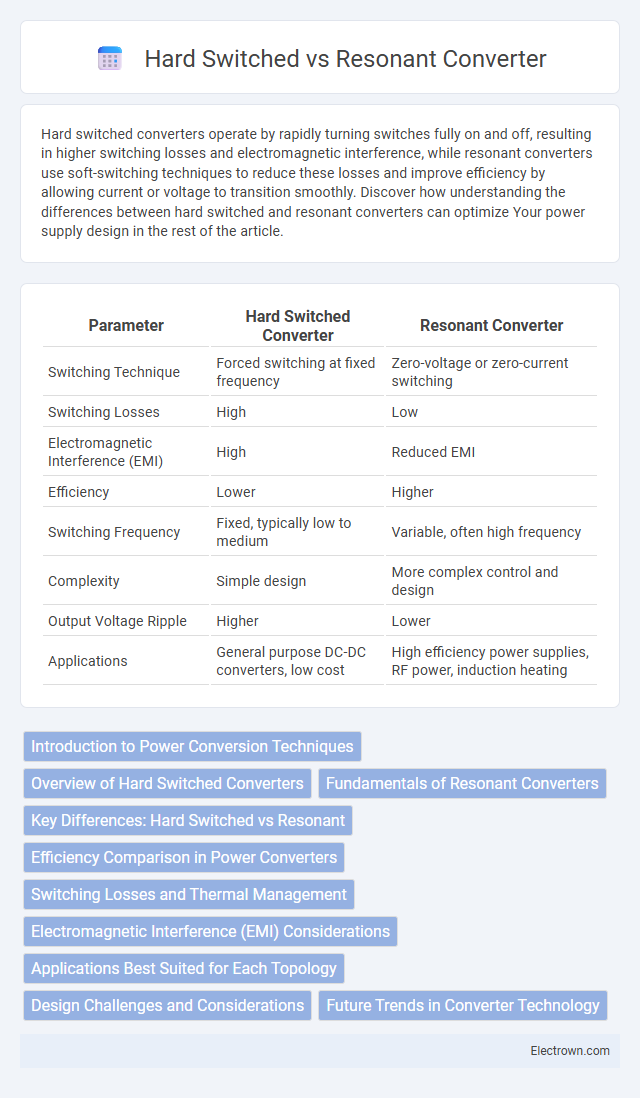Hard switched converters operate by rapidly turning switches fully on and off, resulting in higher switching losses and electromagnetic interference, while resonant converters use soft-switching techniques to reduce these losses and improve efficiency by allowing current or voltage to transition smoothly. Discover how understanding the differences between hard switched and resonant converters can optimize Your power supply design in the rest of the article.
Table of Comparison
| Parameter | Hard Switched Converter | Resonant Converter |
|---|---|---|
| Switching Technique | Forced switching at fixed frequency | Zero-voltage or zero-current switching |
| Switching Losses | High | Low |
| Electromagnetic Interference (EMI) | High | Reduced EMI |
| Efficiency | Lower | Higher |
| Switching Frequency | Fixed, typically low to medium | Variable, often high frequency |
| Complexity | Simple design | More complex control and design |
| Output Voltage Ripple | Higher | Lower |
| Applications | General purpose DC-DC converters, low cost | High efficiency power supplies, RF power, induction heating |
Introduction to Power Conversion Techniques
Hard switched converters operate by rapidly turning power devices on and off, resulting in higher switching losses and electromagnetic interference, while resonant converters use sinusoidal switching to minimize these losses and improve efficiency. Resonant converters achieve zero-voltage or zero-current switching conditions, reducing stress on components and enabling higher frequency operation suitable for compact power supplies. Your choice between these power conversion techniques depends on the trade-off between design complexity, efficiency, and electromagnetic compatibility requirements.
Overview of Hard Switched Converters
Hard switched converters operate by rapidly switching power devices between on and off states, resulting in higher switching losses and electromagnetic interference due to abrupt voltage and current transitions. These converters are simpler in design, commonly used in applications where cost and control simplicity are prioritized over efficiency. Your choice depends on balancing efficiency needs against design complexity and cost constraints in power conversion systems.
Fundamentals of Resonant Converters
Resonant converters operate by utilizing LC tank circuits to enable zero-voltage switching (ZVS) or zero-current switching (ZCS), significantly reducing switching losses and electromagnetic interference compared to hard switched converters. These converters exploit the natural resonance of inductors and capacitors to shape the voltage and current waveforms, achieving high efficiency and improved thermal performance in power conversion. Fundamental types include series, parallel, and series-parallel resonant converters, each optimized for specific load conditions and switching frequencies to maximize energy transfer.
Key Differences: Hard Switched vs Resonant
Hard switched converters operate by abruptly turning power devices on and off, leading to higher switching losses and increased electromagnetic interference (EMI), while resonant converters use sinusoidal or quasi-sinusoidal waveforms to minimize switching losses and reduce EMI. The key difference lies in the switching mechanism: hard switching involves rapid transitions at non-zero voltage and current, causing significant stress on components, whereas resonant converters achieve zero-voltage or zero-current switching, enhancing efficiency and reliability. Your choice between these topologies depends on application requirements for efficiency, thermal management, and electromagnetic compatibility.
Efficiency Comparison in Power Converters
Hard switched converters typically exhibit lower efficiency due to significant switching losses and electromagnetic interference during the abrupt transitions of current and voltage. Resonant converters achieve higher efficiency by leveraging soft-switching techniques, which minimize switching losses and reduce thermal stress on components. Your choice of converter impacts overall system performance, with resonant designs delivering improved power conversion efficiency in high-frequency applications.
Switching Losses and Thermal Management
Hard switched converters experience higher switching losses due to the simultaneous presence of voltage and current during transistor transitions, leading to increased heat generation and demanding robust thermal management solutions such as heat sinks or active cooling. Resonant converters utilize soft switching techniques like zero voltage switching (ZVS) or zero current switching (ZCS), significantly reducing switching losses and thereby minimizing thermal stress on components. Your system's efficiency and reliability improve with resonant converters by lowering thermal management requirements and enhancing overall power density.
Electromagnetic Interference (EMI) Considerations
Hard switched converters generate significant electromagnetic interference (EMI) due to abrupt voltage and current transitions causing high-frequency noise and voltage spikes. Resonant converters minimize EMI by employing soft switching techniques that reduce switching losses and voltage stress, resulting in smoother transitions and less conducted and radiated noise. Proper EMI filtering and layout design remain critical in both converter types to meet regulatory standards and ensure electromagnetic compatibility.
Applications Best Suited for Each Topology
Hard switched converters are best suited for applications requiring simple control and cost-effective solutions, such as basic power supplies and LED drivers, where switching losses and electromagnetic interference (EMI) are manageable. Resonant converters excel in high-frequency, high-efficiency applications such as server power supplies, telecom systems, and induction heating, due to their reduced switching losses and minimized EMI. Choosing between hard switched and resonant topologies depends on balancing efficiency, electromagnetic noise tolerance, and application-specific performance requirements.
Design Challenges and Considerations
Hard switched converters face significant design challenges such as high switching losses, electromagnetic interference (EMI), and elevated thermal stress due to abrupt voltage and current transitions. Resonant converters mitigate these issues by enabling zero-voltage or zero-current switching, which reduces switching losses and improves efficiency but requires precise component selection and complex control strategies to maintain resonance. Your design considerations should include trade-offs between efficiency, electromagnetic compatibility, complexity, and the application's power and frequency requirements.
Future Trends in Converter Technology
Future trends in converter technology emphasize resonant converters due to their superior efficiency and reduced electromagnetic interference compared to hard switched converters. Innovations in wide bandgap semiconductors, such as SiC and GaN, enhance the performance and frequency operation of resonant converters, enabling higher power density and improved thermal management. Integration of advanced control algorithms and digital signal processors further optimizes resonant converter switching, paving the way for smart, adaptive power conversion systems in electric vehicles and renewable energy applications.
Hard switched vs Resonant converter Infographic

 electrown.com
electrown.com